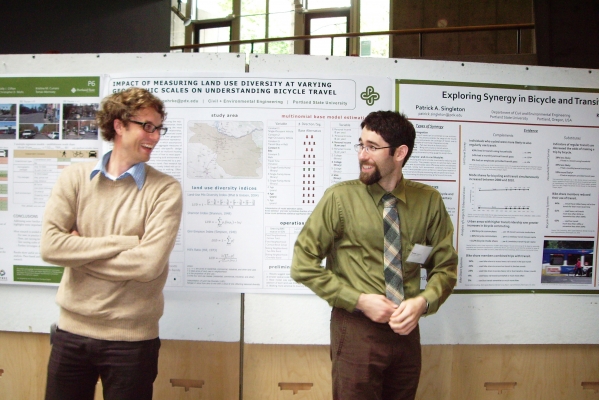Portland State University takes Seattle bike symposium by storm
Posted on June 26, 2013

Steve Gehrke (left) and Patrick Singleton (right) happily display their posters at the Symposium.
Portland, Oregon is known for being a bike city, even called America's Best Bike City by Bicycling Magazine, so it's no surprise at all that Portland State University is full of bike enthusiasts.
Nowhere was that more clearly demonstrated than in Seattle last week, when 14 students and faculty from Portland State turned up to present their research at the International Bicycle Urbanism Symposium.
The Symposium, held on June 19-22 at the University of Washington, explored ways to plan cities around biking. There were international plenary panelists from China, The Netherlands, and New Zealand to offer a look at urban cycling around the world, and a mixture of research into bike-related planning efforts in the United States.
Portland State was there in full force. Faculty researchers Jennifer Dill and John MacArthur presented research on the use of e-bikes in the United States, and what this could mean for the bicycle mode share.
PSU professor Miguel Figliozzi outlined ways of modeling the effects of weather on cycling ridership; a particularly relevant factor in the rainy Pacific Northwest. Krista Nordback, OTREC's resident bicycle counter, specializes in methods of counting bikes. She presented her research on counting bicyclists with the use of pneumatic tube counters on shared roadways.
Knowing the number of bicycles that cruise through an area on any given day can be important for policy decisions; for example, an intersection with a high amount of bike traffic might warrant a bike signal.
To learn more about what that bike signal might look like, you'd have to take a look at Sam Thompson's research: he presented a state-of-the-practice review of existing bicycle signals, which are federally unregulated and lack standardization across jurisdictions.
Sam is a graduate student in the Civil and Environmental Engineering program, one of ten PSU students who attended the symposium. His thesis focuses on bike signals, including research into how cyclists and motorists respond to them. His work is part of the project led by Chris Monsere and Miguel Figliozzi to develop operational guidance for bicycle signals (an ODOT/OTREC project). He enjoyed being at the symposium, and found particularly interesting a panel on GPS data, which discussed various ways of using that data in transportation studies.
Pam Johnson, a PSU engineering student, attended just to soak up the event and gather information for the research project she is working on with Miguel Figliozzi, Chris Monsere, and Krista Nordback to improve counting of bicyclists. Steven Gehrke, another PSU engineering student, presented research which described the impact of land use diversity on bicycle travel.
Other student presenters included Kirk Paulsen, who gave a comparison of bicyclists' performance at various types of intersections (also part of the research on bicycle signals led by Monsere and Figliozzi), and Patrick Singleton, whose research explored the synergy between bicycle and transit use, demonstrating evidence that many bicycle commuters combine their commute with the use of public transit. Singleton also looked at future opportunities for the relationship between transit and biking.
All of the research at the symposium focused on identifying ways that cities can best encourage and accomodate bicycle travel in the future. Tara Goddard presented an evaluation of protected cycling facilities in the US. Mark Haines produced findings from a case study in Portland about the green wave for bicycles.
Alex Bigazzi, a Ph.D. candidate whose research focuses on air quality, presented research about traffic-generated pollution taken in by urban bicyclists.
Kristi Currans and Christopher Muhs presented a study on transportation mode choices, with a survey of individual and establishment-level perspectives on biking. Kristi and Alex Bigazzi are both OTREC scholars and former OTREC students of the year. Sam, Patrick, Tara, Kirk, Steven, and Christopher -- in total, 8 of the 10 students who participated in the conference -- are also OTREC scholars.
Kristi Currans also presented research on behalf of Kelly Clifton, another PSU faculty member who was unable to attend. Clifton's paper was titled Consumer Behavior and Mode Choices, and was an examination of various restaurants, pubs, and stores and the level of bicycle access they offer.
All of the PSU attendees enjoyed the symposium as a chance to get together with fellow bike-lovers and talk about cities of the future. For Nordback, one of the best aspects of the event was its size: small. "You could keep running into the same people," she explained, "so you could really build relationships. There was a really great energy to it. I hope they do it again next year." The symposium focused on long-term planning, with a vision of increased bicycle infrastructure in urban areas within the next 20-30 years.
More information about the symposium can be found here.
